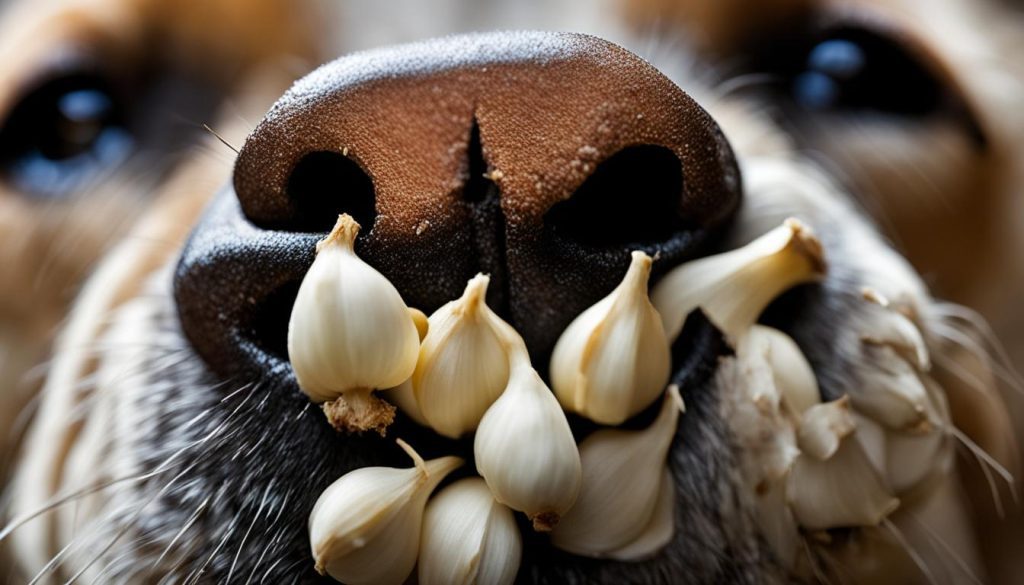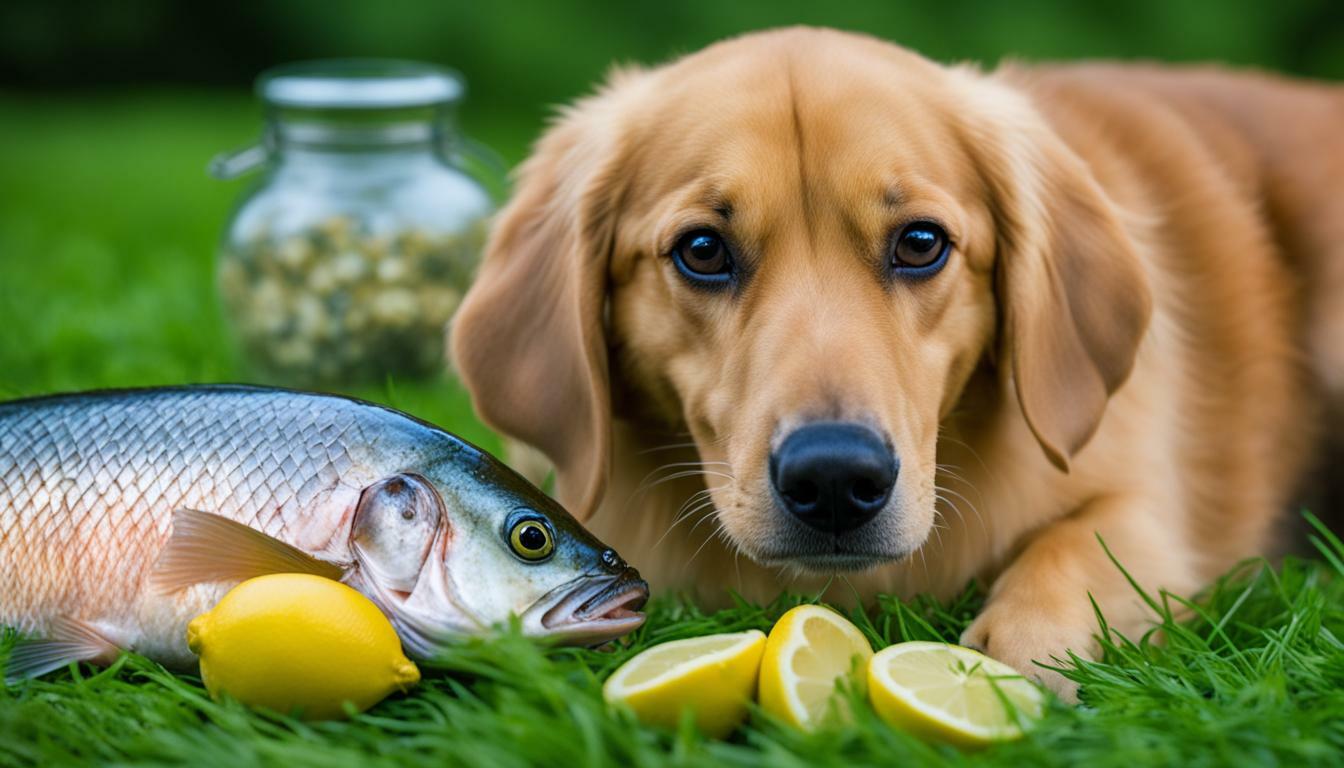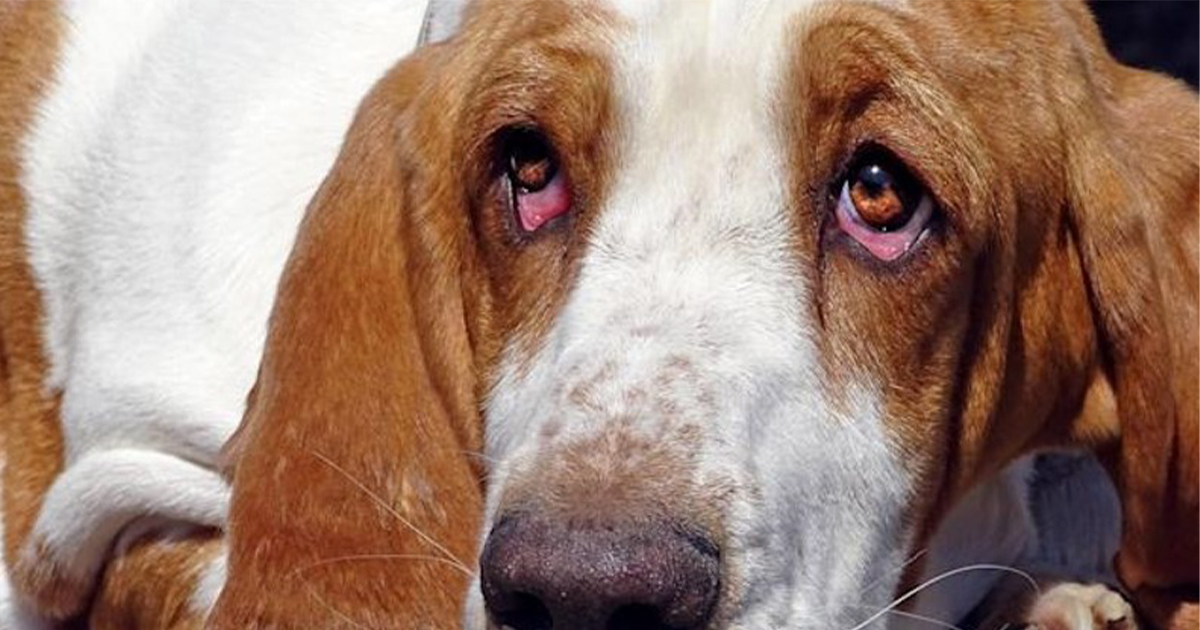As a dog lover and proud pet parent, I always prioritize my furry friend’s health and wellbeing. That’s why understanding the dangers of garlic for dogs is so crucial. Garlic, despite its benefits for us humans, can cause severe harmful effects for dogs and is a commonly misunderstood topic when it comes to canine health. Many are unaware that garlic poisoning in dogs can occur with even a small amount ingested. This begs the question: Is garlic safe for dogs? The answer might surprise you.
Can Dogs Eat Garlic? Yes, they can but they shouldn’t.
- Garlic contains compounds that are toxic to dogs and can lead to severe health issues.
- Small amounts of garlic can cause garlic poisoning in dogs, especially in cats and small breeds.
- Immediate veterinary assistance is essential if your pet ingests garlic.
- Alliums like onions and leeks also pose similar health risks to canine companions.
- Understanding the symptoms and risks of garlic to dogs is imperative for pet owners.
- Garlic and canine health do not mix well – it’s best to avoid feeding garlic to your dog altogether.
The Toxic Truth about Garlic and Canine Health
As a pet owner, I’m constantly exploring ways to maintain my furry friend’s health and happiness. It’s tempting to share our human treats with them, especially when they look at us with those big, begging eyes. But when it comes to garlic, we must understand that what’s beneficial for us can be a hazard for them. We often hear the question, can dogs eat garlic, and it’s crucial to spread awareness that the answer leans heavily towards no, due to the garlic toxicity in dogs.
Understanding Garlic’s Harmful Compounds
My research, much to my dismay, has shown that garlic contains disulfides and thiosulfates—compounds that I had no idea were so harmful to my dog. The thing is, these compounds cause oxidative damage to red blood cells leading to conditions such as hemolytic anemia and methemoglobinemia. Ingesting garlic and dog food that contains this ingredient can make the red blood cells in our pets’ bodies too fragile, leading to their destruction and resulting in severe health consequences for our four-legged companions.
Why Other Alliums Like Onions and Leeks Are a Concern
And it turns out, garlic isn’t the only culprit in the kitchen. Other members of the Allium family, like onions and leeks, also contain these toxic substances. The problem is especially pronounced with onions, and when I learned that for dogs, garlic is about five times more potent than onions, I was stunned. It’s heartbreaking to think that by including garlic in their meals, we might be amplifying the harmful effects of garlic for dogs without realizing it. If the consumption of these ingredients is significant, our canine friends could even require a blood transfusion as part of their recovery process.
Understanding these dangers is the first step in safeguarding our pets’ health, ensuring that the foods we love don’t end up on their plates, and keeping garlic far from their food bowls.
Recognizing Garlic Toxicity in Dogs
If you’re wondering whether can dogs eat garlic, it’s essential to be aware that garlic can be quite harmful to our canine companions. As a pet owner, recognizing the symptoms of garlic toxicity in dogs is a critical part of ensuring their well-being. It might surprise you to learn that symptoms often do not appear immediately and could take several days to manifest.
Some of the initial signs of garlic poisoning in dogs include gastrointestinal issues such as vomiting and diarrhea. These can occur within 24 hours of ingestion. However, the more severe symptomatology, indicative of anemia, like lethargy, pale or yellow gums, and rapid breathing, may only become apparent several days later. It is crucial to observe your dog closely if you suspect they have ingested garlic—you might notice additional signs of distress such as abdominal pain, discolored urine, or a rapid heart rate.

I can’t stress enough how serious these symptoms can be. Time is of the essence, and upon noticing any of these symptoms, immediate veterinary care is necessary. Early intervention can make all the difference in preventing potentially fatal complications. Always err on the side of caution; if your dog ingests garlic, it’s best not to wait for symptoms to develop. Contact your vet right away. Ultimately, no matter how much we might enjoy garlic in our meals, it’s clear that our furry friends are better off without it.
Can Dogs Eat Garlic? Debunking Common Misconceptions
As a dog owner, I am always looking for ways to ensure the health and happiness of my furry companions. Often, I come across various tips and tricks touted by passionate pet lovers, but importantly, I’ve learned that it’s essential to delve into these claims, especially when it involves something like garlic. Because really, can I feed garlic to my dog safely? Let’s uncover the truth behind some of these misconceptions and see what alternatives to garlic for dogs might be out there.
The Myth of Garlic as a Flea Preventative
One persistent piece of advice that circulates in pet communities is the use of garlic to repel fleas from dogs. I understand the appeal of natural remedies for pests, but after digging into research and consulting with veterinarians, it’s become clear that garlic isn’t the harmless repellant many believe it to be. In fact, due to the toxic compounds in garlic that affect canine health, using it as a flea preventative can do more harm than good to your dog.
Garlic in Home Recipes vs. Commercial Dog Foods
I’ve also observed a trend of garlic being added to home-cooked dog food recipes or being present in some commercial dog foods and supplements. I must emphasize that the inclusion of garlic in these products does not necessarily equate to a health benefit for our dogs. The key takeaway is that while garlic may have medicinal properties for us, the risks it poses to dogs far outweigh any perceived advantages, making it a no-go for our canine friends’ diets.
In conclusion, while it can be tempting to share our favorite human foods with our pets, it’s crucial to remember that their bodies do not always metabolize ingredients as ours do. The saying “better safe than sorry” rings especially true when it comes to garlic and canine health. Instead, seek out safe and wholesome alternatives to garlic for dogs that can enrich their diet without the risks of toxicity.
How Much Garlic Is Dangerous? Understanding Dosage and Risk
As a pet lover, I’m always concerned about what’s on my dog’s plate. You’ve probably come across the question, “can dogs eat garlic?” and found mixed opinions. But when it comes to garlic and canine health, it’s not a matter of if it can be occasionally safe, but rather understanding the dangerous levels of garlic for dogs. It’s essential to be aware that garlic dosage for dogs is a complex issue, as various factors contribute to the risk level, including a dog’s size, breed, and overall health.

The Varying Sensitivities Between Dog Breeds and Sizes
Different dog breeds and sizes mean varying tolerances to what they can and cannot ingest. Smaller breeds often exhibit greater sensitivity to substances like garlic, and the threshold for what could be considered a toxic garlic dosage for dogs is much lower for them. But it’s not just size that matters. Some breeds may have a genetic predisposition that amplifies their susceptibility to components in garlic, making even a tiny clove a significant hazard.
Incidental Garlic Exposure vs. Direct Ingestion
When it comes to accidental or incidental garlic exposure, a one-time drop of garlic-infused food licked off the floor might not spell disaster. However, how much garlic is toxic to dogs is still a pivotal question because even small, repeated exposure over time can lead to chronic toxicity. Direct ingestion of garlic, especially in scenarios where a curious pooch investigates the kitchen countertop, calls for immediate action. With garlic’s high concentration, it doesn’t take more than a small dose to reach dangerous levels of garlic for dogs.
As a responsible pet owner, understanding which foods are safe and which could lead to an emergency is a part of loving and caring for your furry family member. Keep in mind that no matter how nutritionally beneficial garlic may be for us, it doesn’t offer the same benefits to our canine companions and poses unnecessary risks. Consider safe and dog-friendly alternatives when looking to boost your pet’s diet or health regimen.
Immediate Steps to Take If Your Dog Consumes Garlic
Discovering that my dog has eaten garlic always spikes my anxiety. **Immediate response to garlic ingestion in dogs** is crucial for their health and wellbeing. Here’s what I do to act swiftly: first, I ensure that there’s no more garlic within reach. The quantity my dog has consumed is the next detail I need to figure out, as it’s a pivotal factor when it comes to the severity of the potential toxicity.
Once I know how much garlic my dog has eaten, I weigh my pet if I’m unsure of their current weight, because size matters in this scenario. The next step is to **contact my veterinarian or an emergency veterinary service** without delay. **What to do if your dog eats garlic** is not something I take lightly, so I seek professional guidance immediately. Should my vet advise so, I’m prepared to induce vomiting, but I never take that step without their say-so.
After these immediate measures, I’m prepared to transport my dog to the clinic for further treatment. First aid for garlic poisoning in dogs is not enough on its own—professional care is essential to mitigate the effects of garlic ingestion. With these steps, I’m comforted knowing I’m doing everything in my power to ensure my dog’s safety.
Conclusion
The topic of whether can dogs eat garlic has been comprehensively analyzed, revealing the stark reality of garlic toxicity in dogs. As a passionate pet owner and health advocate, I can’t stress enough the importance of understanding the significant difference between the benefits of garlic to humans versus the risks it poses to our beloved pets. Garlic and other related alliums contain compounds that can wreak havoc on a dog’s body, specifically affecting their red blood cells and leading to dangerous forms of anemia.
During my exploration of this subject, I’ve emphasized the importance of swiftly recognizing the signs of garlic and canine health issues. If your furry friend exhibits any symptoms of garlic toxicity, it is imperative that you consult with a veterinarian without delay. Every moment counts, and getting professional help can save your pet from the severe repercussions of garlic poisoning.
I urge all dog parents to prioritize their pet’s diet and well-being by avoiding garlic and opting for safer, tested food options. Before introducing any new food item to your dog’s meal plan, always have a conversation with your veterinarian to ensure it’s safe. Remember, taking preventative measures and being informed about what foods are harmful are key steps in protecting our pets from unnecessary harm and fostering their long-term health and happiness.
FAQ
Can dogs eat garlic?
No, dogs should not eat garlic. Garlic contains disulfides and thiosulfates which are toxic to dogs and can cause significant health issues such as hemolytic anemia, methemoglobinemia, and other symptoms of toxicity.
What are the harmful effects of garlic for dogs?
The harmful effects of garlic for dogs include damage to red blood cells leading to hemolytic anemia, Heinz body anemia, and methemoglobinemia. Signs of garlic toxicity in dogs can include vomiting, diarrhea, lethargy, pale gums, abdominal pain, and rapid breathing.
How does garlic poisoning in dogs manifest?
Symptoms of garlic poisoning in dogs may include vomiting, diarrhea, lethargy, pale or yellow gums, rapid breathing, abdominal pain, discolored urine, and a rapid heart rate. These symptoms can take days to appear after ingesting garlic.
Is garlic safe for dogs in any amount?
Garlic is not considered safe for dogs in any amount. Even small quantities can lead to toxicity, especially in smaller or more sensitive breeds. It’s important to avoid feeding dogs garlic and seek veterinary advice for safer alternatives.
Why are other alliums like onions and leeks also a concern for dogs?
Other alliums such as onions, shallots, leeks, and chives contain similar compounds to garlic that are also toxic to dogs. Like garlic, they can cause damage to red blood cells and lead to anemia and other related health issues.
Can garlic be used as a flea preventative for dogs?
No, garlic should not be used as a flea preventative for dogs. Not only is it ineffective, but it also poses a risk of toxicity to dogs. There are safer and more effective flea prevention treatments available that are specifically designed for dogs.
Is it safe to include garlic in homemade dog food recipes or give dogs garlic supplements?
It is not safe to include garlic in homemade dog food recipes or give dogs garlic supplements due to the risk of toxicity. It’s best to avoid garlic entirely and to consult with a veterinarian for appropriate dietary recommendations for your dog.
How much garlic is dangerous to a dog?
Even small amounts of garlic can be dangerous to a dog. Scientific studies have suggested that 15 to 30 grams of garlic per kilogram of body weight can lead to harmful changes in a dog’s blood. Pet owners should completely avoid feeding garlic to their dogs.
Are some dogs more sensitive to garlic than others?
Yes, some dogs may be more sensitive to garlic than others. Factors such as a dog’s breed, size, and health history can affect their sensitivity to garlic. Smaller breeds and those with pre-existing health conditions may be at greater risk of poisoning.
What should I do if my dog accidentally eats garlic?
If your dog accidentally eats garlic, immediately prevent access to any more garlic and contact your veterinarian or an emergency veterinary service right away. Do not attempt to induce vomiting unless instructed by a professional, and follow all veterinary guidance for your dog’s treatment.






